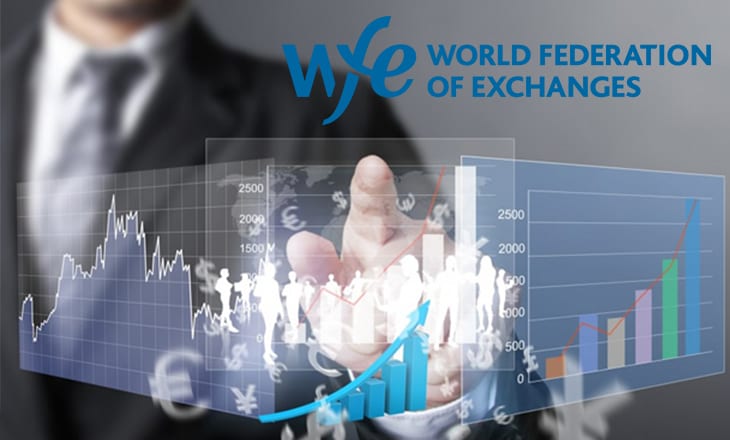The World Federation of Exchanges (WFE), which represents more than 200 market infrastructure providers including exchanges and CCPs, just published its 2016 Market Highlights.
Perhaps highlighting the somewhat exceptional nature of 2015, markets were more subdued in 2016, with most regions showing only modest increases on 2015 figures across the major primary and secondary market indicators, coupled with a number of more significant decreases.
According to the WFE’s full-year statistics, the key trends of 2016 were as follows:
- Global market capitalisation was up 4.4% on 2015, driven by the 10.8% and 0.9% rise in the Americas and EMEA regions respectively. Asia-Pacific ended the year down 0.5% versus the end of 2015. Global market capitalisation in H2 2016 increased relative to H1 2016 by 5.7% overall.
- Globally the value of share trading and the number of trades declined by 26.9% and 15.5% on 2015, driven primarily by the 47.2% and 26.1% drop in these figures in the Asia-Pacific region.
- The fall in value and volume traded most likely reflects the influence of key events in the Asia-Pacific region, such as the sharp sell-off and trading halt on Chinese exchanges in early January 2016; concerns over the likelihood of an interest rate increase in the US; uncertainty over the future of trade policy with the Americas; and other political and economic events across the Asia-Pacific region.
- In the Americas and EMEA regions, the number of trades increased by 5.2% and 4.7% respectively but the value of share trading was down 4.6% and 15.3% on 2015. Overall in H2 2016, the value traded and volume traded were down 23.3% and 7.7% on H1 2016, thus driving the global slowdown in turnover and trades.
- The number of newly listed companies, investment flows through IPOs and non-IPO investment flows were all down (35.8%, 36.8% and 24.7% respectively) on 2015.
- All regions experienced a decline in investment flows, but this was particularly pronounced in the Americas (down 46.2%). The main driver of this trend was the US, in an election year and with uncertainty over regime change and consequential shifts in policy.
- The EMEA region experienced the largest percentage drop in non-IPO investment flows. In Europe, which accounted for 93.4% of all investment flows in the region, the 18% drop in investment flows took place against a backdrop of sluggish economic momentum; concerns over the health of the banking system; and uncertainty in the region post Brexit.
- Exchange Traded Derivatives (ETD) volumes (as represented by number of contracts traded) ended the year 2% down on 2015, driven by a drop in volumes of equity derivatives and stock index derivatives. The full year saw a reversal of the trend observed in H1 2016, when the growth in volumes of commodity and currency derivatives saw ETD volumes up by 1.4% on H1 2015.
- Volumes traded in single stock options and futures dropped by 9.2% and 14.5% respectively. The Americas, where 79.4% of options contracts are traded, and the EMEA region, where 53% of single stock futures are traded, experienced a decline in volumes of 10.3% and 15.5% respectively.
- Equity index based options and futures saw volumes decline by 16.6% and 15.7% respectively. Divergent trends were witnessed across regions. The Asia-Pacific region experienced a sharp drop in volumes traded in index options and futures (down 43% and 49.6%) respectively, whereas the EMEA and Americas regions saw a pickup in number of contracts traded in these products versus 2015.
- Volume of commodity options and futures traded saw a pickup in all regions with a worldwide increase of 10.5% and 28.7% respectively. The Americas, which account for about 80% of commodity options contracts traded, and the Asia-Pacific region, where 68% of commodity futures are traded, were the drivers of this change, with growth rates of 9.4% and 26.7% respectively. Volumes were driven by the pickup in energy assets such as natural gas and oil, metals including silver and iron ore, and agricultural commodities like soybean and sugar.
- For currency futures, the volume traded in 2016 was 4.7% higher than in 2015. However, this includes a 5.6% decrease in the number of contracts traded in the EMEA region, where over 46% of the world’s currency futures are traded.
Nandini Sukumar, CEO WFE, commented:
The most startling statistics for 2016 – the sharp downward trends around IPOs and investment flows – reflect global uncertainty triggered by events such as Brexit and the US election.
It is also interesting to note the reversal in the fortunes of ETDs,” added Siobhan Cleary, Head of Research & Public Policy, WFE. After a bumper start in the first half of 2016, ETDs finished the year down 2%, driven primarily by lower volumes of equity and stock index derivatives.
